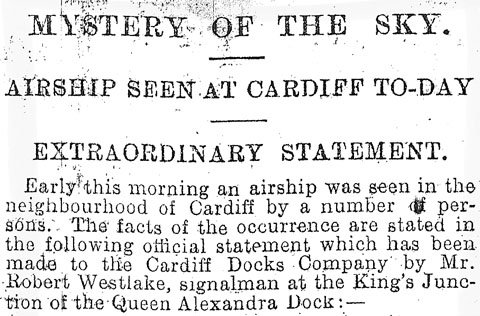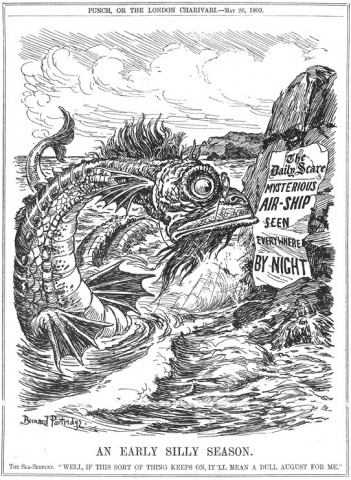
Only the Globe carries (p. 4) phantom airship stories today (out of my sample, at least), but it has two, and they head the column rather being buried down the page. The first is from Cardiff in Wales, where a number of dock workers saw an airship in the early hours of this morning, and were willing to have their names included in this ‘official’ statement by signalman Robert Westlake:
At 1.15 this morning (19 May), while attending to my duty signalling trains at the King’s Junction, Queen Alexandra Dock, I was startled by a weird object flying in the air. In appearance it represented a boat of cigar shape, making a whizzing noise. It was lit up by two lights, which could be plainly seen. It was travelling at a great rate, and was elevated at a distance of half a mile, making for the eastward. There were many men working at the time loading the s.s. Arndale, and the airship was seen by most of them. Messrs. W. Morrison (pointsman), C. Harwood (traffic foreman), W. John, C. Hayman, J. Rogers, and C. Bray (coal tippers), and the third mate of the Arndale all testified to the facts recorded above.
The airship came from the direction of Newport, took a curve over the docks, and passed over the Channel towards Weston, being clearly in view for a minute or two. It could, it is stated, have been seen longer, but that the lights on board were suddenly extinguished.
Other workmen confirmed Westlake’s account. One said that ‘The night was clear, though there was no moon, and the airship could be distinctly seen, and the whizzing of its motor was heard by us all’.
The second story is not from Britain at all, but from Norway. The Norwegian Shipping Gazette has published an account by Captain Egenes of the steamer St. Olaf. On the night of 14 May, in the eastern part of the North Sea (i.e. not close to Britain), ‘an airship, sailing at low altitude, approached his vessel and directed a searchlight upon the decks’. It then moved off and did the same to another, unnamed steamer. The Shipping Gazette suggests that the airship is carried by day on board one of the German warships conducting maneuvers in the North Sea.
So yesterday’s trend of sightings outside the original focus in East Anglia has continued. Both of these new incidents seem very well attested; both are widely separated geographically (although, of course, widely separated in time, too). A searchlight shone onto a ship’s deck seems fairly unambiguous; the number of witnesses at Cardiff is impressive. Do Norwegian sea captains worry about the Zeppelin menace? Do Welsh dock workers often have collective delusions?
The conservative papers are much exercised by the defence of the realm today. The Standard‘s first leading article today is a denunciation (p. 8) of the Liberal government’s record in this area:
The continuance of the present Government in office involves actual and present danger to the security of these islands. Year by year, for three years, they have steadily reduced our defences; year by year, plausible lawyers have employed every trick of forensic sophistry to disguise the truth; until to-day, we have a depleted Army, a reduced Volunteer force which is not even supposed to be available upon the outbreak of war, no Militia, and a Navy scaled down to a one-Power standard, starved of men, and without stores and munitions. These are the sober facts. They have all been cynically denied by his Majesty’s Ministers — but facts are stronger than lawyers, and live longer.
The Standard also has a somewhat overwrought report (p.9) by John Foster Fraser on a speech made by Lord Roberts of Kandahar in the House of Lords last night. Roberts, a retired field marshal and the last Commander-in-Chief of the Army, claimed that Britain was practically defenceless against invasion and that the efficiency of the Army’s reserves must be looked into.
The day was waning, the House was in shadow. Rows of men, some with historic lineage, others with quarterings of yesterday, watched the noble lord: bronzed, taut-figured, with voice sharp, almost metallic, with the rap of soldierly command in it — an old man now, but the fire in his blood and yet something of the ring of despair in his tone. He dreaded the future.
By way of contrast, the Manchester Guardian has a full report (p. 14) on the annual meeting of the Peace Society, held at the Mansion House in London yesterday. A motion moved by the Bishop of Hereford deplored the international competition in armaments, which leads to an ‘increasing sense of insecurity and mutual suspicion’ between nations, and called on the government to negotiate with other states to limit and eventual reduce armaments. Lord Weardale seconded the motion, adding that
there seemed to be in this country a peculiar tendency for the public mind to be seized by certain spasms of panic which swept through the country fanned by an unscrupulous press. It seemed to be a sort of influenza. (Laughter.) Scientists were busily engaged trying to find the bacillus of influenza; he wished they would try to find the bacillus of the war-like feeling.
An example of this war flu might be the question to be asked in the House of Commons today by Sir John Barlow, a Liberal MP (Manchester Guardian, p, 7):
To ask the Secretary of State for War whether he has any information showing that there are 66,000 trained German soldiers in England, or that there are, in a cellar within a quarter of a mile of Charing Cross, 50,000 stands of Mauser rifles and 7½ millions of Mauser cartridges, that is, 150 rounds per rifle.
It seems that Barlow himself does not believe this story, which was printed in a ‘West of England’ newspaper recently and mentioned in a speech by the Mayor of Bath. Instead he wants an ‘authoritative denial’ from the War Office, as it was advisable in the public interest that such allegations as those referred to should be set at rest if not in accordance with facts’. So it isn’t just airships and spies which troubling the British imagination at the moment.
![]() This work is licensed under a Creative Commons Attribution-NonCommercial-NoDerivatives 4.0 International License.
Permissions beyond the scope of this license may be available at http://airminded.org/copyright/.
This work is licensed under a Creative Commons Attribution-NonCommercial-NoDerivatives 4.0 International License.
Permissions beyond the scope of this license may be available at http://airminded.org/copyright/.




It is interesting to note how these objects are said to be changing their shapes over the years. First they were Cigar shaped, later during the forties and fifties they were Saucer shaped and now they are Triangle shaped.
The whole reading your posts through ellipsis is fun, Brett. Now I’m imagining 66,000 (not a boring 60,000, 66,000!) trained German soldiers crouching in a basement in Charing Cross, waiting for the balloon to go up.
Oh, wait, it did, didn’t it?
By the way, as a personal request, if you see anything related to optics and gunsights, could you pass it on? I think that this particular controversy didn’t peak until 1911, but my memory is hazy.
Avinash:
I think the expectations of the observers played a large role in the airship scares. It’s pretty clear that they are inferring the shape from seeing a pair of lights and expecting that a dirigible balloon is strung between them.
Erik:
I’ll keep an eye out, but I’ve already filtered out most everything not aerial. I do have some naval stuff though.
Pingback: Airminded · Saturday, 22 May 1909
Pingback: Airminded · Thursday, 20 May 1909
Pingback: Airminded · Post-blogging the 1909 scareships: thoughts and conclusions